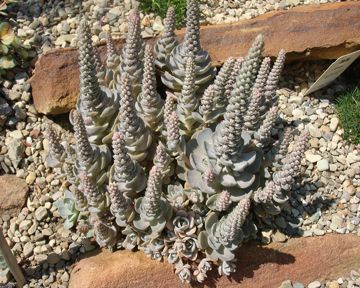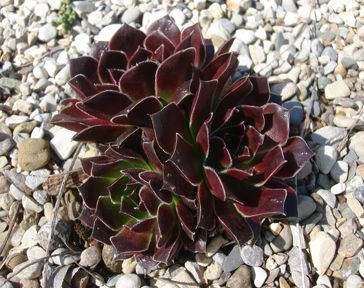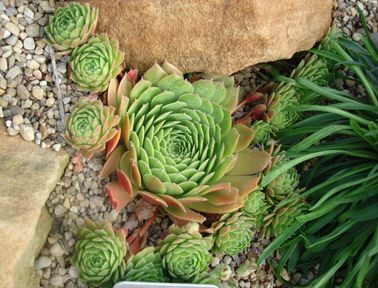Succulent identification chart & growing info, climate zones, conditions, etc. for a wide variety of succulents
General Characteristics
Succulents by their nature are drought resistant and prefer a coarse, well drained coarse gravely soil. However, most are very hardy and tolerant of our soils and growing conditions. For those that require special treatment, planting instructions can be provided.

We grow several types of succulents: Cacti, Hens and Chickens (Houseleeks), short and tall Stonecrop (Sedum) and Yucca, as well as other unusual ones. The Cacti, Hens and Chickens, and short Sedums are all low growing and work well in rock gardens or ‘front of border’ in flower gardens. The tall growing Sedum and Yucca are good specimen plants for mid to back of flower beds.

Succulents are considered by many people to be mainly foliage plants and are not noted for their blooms. Most do bloom, however, some in early summer, and many in late summer to early fall. Some blooms are very eye catching. Many are very attractive to butterflies. As foliage plants, succulents provide a unique texture and a wide variety of colors and variegation.
Some succulents are evergreen and provide winter interests. For instance, hens and chicks being alpine plants, prefer cooler weather and many turn from green to shades of red during the colder months. Yuccas are evergreen and are quite striking, standing above the snow on cold winter days. The tall growing sedums all go dormant with the first hard frost. Cacti go dormant in the fall, turning gray green to brown until the warm spring weather returns.

There are several different groupings of Hens and Chicks. The two most common are Scientific Name: Jovibarba and Scientific Name: Sempervivum. Individual plants of the two look very similar. The difference is that Jovibarba grow chicks on very short stolens(stems) that make for a compact clumping plant mass. Sempervivums produce the chicks on longer stolens that allow the plant to slowly spread and eventually form a sizeable ground cover.
Sedum, in most cases, are easy to grow. Most of the low growing varieties spread slowly but given time will develop a dense mat. Others are clump forming. The taller varieties are all clump forming. To prevent them from being top-heavy at fall bloom time, you can trim them back by a third to a half in mid June. Sedums actually prefer poor soil and little or no fertilizer.
There are several cacti that perform well in Zone 5 and will winter over outdoors. However they all require well drained soils for both summer and winter. Rock gardens or raised beds with coarse soil is best.
Succulents attract bees and butterflies when they bloom and are very disease and insect resistant.

Succulents Description List

Inspiring, practical and richly photographed, this comprehensive guide offers creative ideas and DIY projects using beautiful low-maintenance, water-wise plants
Succulents are the ultimate easy-care plant: versatile, effortless to grow both indoors and outdoors, and drought tolerant. From Aloe and Agaves, to Senecio and Taciveria, this handbook by leading garden expert Robin Stockwell highlights 200 of the easiest, most useful, and gorgeous plants, and shares advice on care and cultivation. Readers will find inspiration for imaginative and exciting new ways to use succulents in striking garden designs, containers, vertical walls, and indoor arrangements, as well as step-by-step projects, such as living bouquets and terrarium ornaments.
This is the essential reference for landscapers, home gardeners, and anyone looking for a thorough introduction to the perfect plant for modern times.
